Those who accepted Peter’s message were baptized, and about three thousand were added to their number that day. –Acts 2:41
“That day” was the Feast of Pentecost, fifty days after Jesus’ ascension into heaven. Peter, newly filled with the Holy Spirit, had just delivered a sizzler of a sermon to a Jerusalem crowd who were “cut to the heart.”
When they asked, “What shall we do?” Peter replied, “Repent and be baptized” (vv 37-8), whereupon they all trooped over to the local swimming hole, which wasn’t just one pool but dozens of mikva’ot, the ritual baths used for washing prior to Temple worship. These pools were located just beyond the large public square at the foot of the broad staircase on the southern side of the Temple Mount. This whole area would have been jam-packed that day, both because of the Jewish feast and because of the Holy Spirit’s massive publicity campaign for Jesus.
The mikveh (singular) pictured in the photograph was almost certainly one of the pools used to baptize the 3000 new converts. Moreover, either it or a similar one nearby was undoubtedly used by Jesus Himself, who like any worshiper would have been obedient to the law of ritual cleansing before going up to the Temple into the presence of God.
Today our bathtubs are made of acrylic or fiberglass. But in Jesus’ time they were made of stone, usually cut right into a rock outcrop and then plastered. The word mikveh means collection, referring to a collection of water for washing, but this washing was more often for ritual purity than for cleanliness. The water in a ritual bath had to be “living water”—that is, running, as from a spring, or at least fresh, as from rain, but not stored or carried in a vessel (though stored water could be mixed with fresh in a pool called an otzar). And the bath had to be deep enough for total immersion. The bather didn’t stretch out and relax as we do, but simply went down a few steps into the water, then out again. In many mikva’ot the stairs had a partition to separate the unclean side from the clean side.
Such stone baths were common because Jews had to purify themselves often: before the sabbath and other occasions, and after certain events that made them unclean, including contact with a dead body or a grave, or even slight physical contact with a non-Jew in the marketplace. When the Pharisees criticized Jesus’ disciples for not washing before eating, Jesus retorted that uncleanness comes not from the outside but from the inside (Mk 7:18). Hence, while Jews had to wash ceremonially again and again, Christians do so only once, in baptism, which is “not the removal of dirt from the body but the pledge of a good conscience toward God” (1 Pet 3:21). As the dead are commonly immersed in earth, immersion in water symbolizes death to self and new life in Christ, who said of His own impending death, “I have a baptism to undergo, and how distressed I am until it is completed!” (Lk 12:50)
To this day conversion to Judiasm requires immersion in a mikveh, a rite called tevilah, wheras Christian baptism is not always by immersion but can take other forms. A Presbyterian (who baptizes by sprinkling), while chatting with a Baptist (who practices immersion), asked, “So tell me, if a fellow went into the water up to his waist, would that count?”
“No,” replied the Baptist, “that’s not enough.”
“What if he went in up to his neck?”
“No, he has to be fully dunked.”
“Up to his nose?”
“Still not enough.”
“You see?” concluded the Presbyterian. “It’s the little bit of water on the top of the head that counts.”
Photo © Galyn Wiemers
Next Week: Solomon’s Colonnade
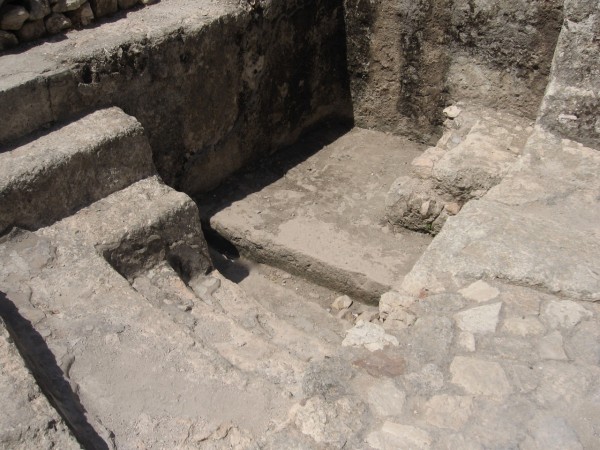

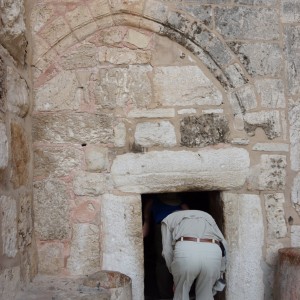
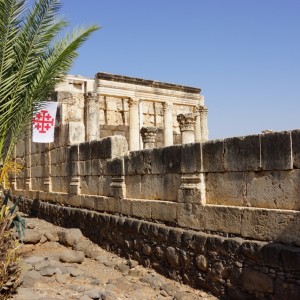
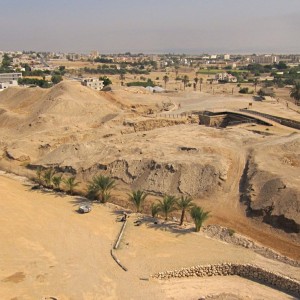
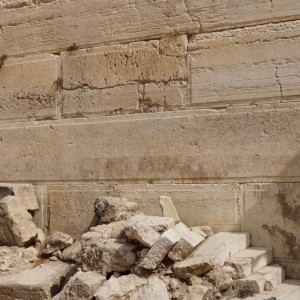
God bless you and thank you Mike. I’m glad you are able to offer your strength to so many works in process! Praise the Lord for that! It’s no problem at all. I too am a very slow reader and understand completely.
I’m sorry, Angela, but I get too many such requests to accomodate them all. I’m a slow reader, so I have to limit my reading of manuscripts to writers I know personally. I do wish you all the best with your project, and I’d love to know about it when it’s published.
I just read about your book Practicing the Presence of People. Sounds like a POWERFUL book! I too am a HUGE fan of Practicing the Presence of God, by Brother Lawerence. I was handed the book while still a teenager in highschool and have shared it with many others since.
I’d love to read it again, and read your book about applying it’s principals to people.
I wanted to ask you if you’d like to offer your insights to my current writing project?
As I am in part 3 of writing my book, (Raising Jesus) and really enjoyed this article and your blog post/chapter about Gabriel’s view of visiting Mary- I was wondering if you would enjoy reading the first part (About 20,000 words) of my book and offering me your insights. (This part includes Gabriel’s visit to Mary)
My goal- apart from writing a riveting read that will capture the hearts of all and help lead them into faith in Jesus, is to write something that is as true to our best archaeological/ historical information to date, and most importantly true to scripture.
Part 1 and 2 have been processed with 4 beta readers and 3 grammar editors so far- so the reading shouldn’t be too rough at this point. Would you like to take a look and offer me any feedback that may come to your mind for improving it? Thanks again for your blog. I enjoy it! – I would have sent this question as a personal email, but I couldn’t find one on your contact page.
I appreciate the reply. Thank you Mike. By the way, I shared your joke with our pastor and he really appreciated it! Thank you for a great article.
I’m sorry, Angela, but I don’t recall encountering anything about this in my own research, and I’m not sure where to point you. But thanks for you comment.
I really enjoyed this post. I am writing a historical fiction about this period, and was looking everywhere for information on how modesty was addressed around the mikveh of Jesus’s day. While on a tour of the area our guide said, nudity was not a sexual / immoral matter, and that mikvehs were quite public displays of nudity. I’ve seen some images where the mikveh seem to be some what concealed in walls or cave type enclosures. I’ve wondered if there were curtains set up about the mikvehs. Did men and women use the same mikvah one after another, or did one gender use it as a group first and then the other? Do you have any idea how nudity, modesty, and propriety were exercised (or not?!) around the mikveh? I’ve been searching EVERYWHERE for help with this and I’d love it if you had any resources to point me to about the matter. Thank you so much!
Funny joke, Mike! 🙂